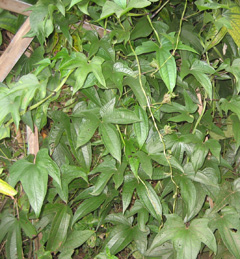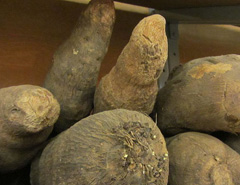 |
|
https://edibleplants.org/ |
 |
| https://edibleplants.org/ |
Translate this page:
Summary
Dioscorea trifida or Cush Cush Yam is a perennial climbing plant with a tuberous rootstock and twining stems about 3 m long. It can be found in northern part of South America where it is widely cultivated for its edible tuber. The tubers can be boiled or baked. It is a flowering plant. The flowers are green with six tiny tepals in the axils. The fruit is a winged, lightly hairy capsule.
Physical Characteristics

 Dioscorea trifida is an evergreen Perennial Climber growing to 3 m (9ft) by 0.5 m (1ft 8in) at a fast rate.
Dioscorea trifida is an evergreen Perennial Climber growing to 3 m (9ft) by 0.5 m (1ft 8in) at a fast rate.
See above for USDA hardiness. It is hardy to UK zone 10. The flowers are pollinated by Wind, Insects.
Suitable for: light (sandy), medium (loamy) and heavy (clay) soils and prefers well-drained soil. Suitable pH: mildly acid, neutral and basic (mildly alkaline) soils. It can grow in semi-shade (light woodland) or no shade. It prefers moist soil.
UK Hardiness Map
US Hardiness Map
Synonyms
Dioscorea brasiliana Poir. Dioscorea braziliensis Willd.
Plant Habitats
Edible Uses
Edible Parts: Root
Edible Uses:
Root - cooked[ 300 ]. Boiled or baked, some forms have an excellent flavour[ 300 ]. The cooked flesh is smooth in texture, attractive and of an unusually rich flavour that is readily appreciated and sufficiently moist in the mouth[ 301 ]. Roots are about 15 - 20cm long and 6 - 8cm in diameter[ 300 ]. The tuber is about 38% waxy starch that lacks amylose and has potential uses as a binder and thickener in food processing.
References More on Edible Uses
Medicinal Uses
Plants For A Future can not take any responsibility for any adverse effects from the use of plants. Always seek advice from a professional before using a plant medicinally.
None known
References More on Medicinal Uses
The Bookshop: Edible Plant Books
Our Latest books on Perennial Plants For Food Forests and Permaculture Gardens in paperback or digital formats.

Edible Tropical Plants
Food Forest Plants for Hotter Conditions: 250+ Plants For Tropical Food Forests & Permaculture Gardens.
More

Edible Temperate Plants
Plants for Your Food Forest: 500 Plants for Temperate Food Forests & Permaculture Gardens.
More

More Books
PFAF have eight books available in paperback and digital formats. Browse the shop for more information.
Shop Now
Other Uses
Vines of other Dioscorea species are grown as ornamentals.
Special Uses
Food Forest
References More on Other Uses
Cultivation details
A plant of the moist tropics and subtropics. It grows best in areas where annual daytime temperatures are within the range 18 - 26°c, but can tolerate 10 - 36°c[ 418 ]. It can be killed by temperatures of 7°c or lower[ 418 ]. It prefers a mean annual rainfall in the range 1,200 - 2,600mm, but tolerates 1,000 - 4,000mm[ 418 ]. This species grows better at lower temperatures than most tropical yams[ 300 ]. Prefers a sunny position, tolerating some shade[ 418 ]. For best yields, most yams require a deep, well-drained, sandy loam that is not liable to water-logging[ 300 ]. This species will succeed in a wide range of soils so long as there is plenty of organic matter and they are well drained[ 300 ]. Prefers a pH in the range 6 - 6.7, tolerating 5.3 - 8[ 418 ]. Daylengths of more than 12 hours are preferred during the early growing season since this encourages vegetative growth; daylengths of less than 12 hours towards the end of the growing season will encourage tuber formation and development[ 300 ]. Crops can be obtained in 9 - 11 months from planting, yields of 15 - 20 tonnes per hectare have been achieved[ 300 ]. Plants produce groups of 5 - 50 tubers from enlarged stolons or runners[ 300 ]. This is perhaps the only cultivated yam species that has retained its full reproductive potential through seed formation[ 300 ]. There are some named varieties[ 46 , 300 ]. A dioecious species, both male and female plants need to be grown if seed is required.
References Carbon Farming Information and Carbon Sequestration Information
Temperature Converter
Type a value in the Celsius field to convert the value to Fahrenheit:
Fahrenheit:
The PFAF Bookshop
Plants For A Future have a number of books available in paperback and digital form. Book titles include Edible Plants, Edible Perennials, Edible Trees,Edible Shrubs, Woodland Gardening, and Temperate Food Forest Plants. Our new book is Food Forest Plants For Hotter Conditions (Tropical and Sub-Tropical).
Shop Now
Plant Propagation
Seed - sown in containers and planted out at the beginning of the growing season[ 300 ]. Cuttings of tubers. Small tubers can be cut into 2 - 4 sections, larger ones into 6 - 8 sections. Each section should have 2 - 3 dormant buds. The cut tuber is often left in the sun for several hours to promote wound healing and reduce the risk of fungal infection[ 300 ].
Other Names
If available other names are mentioned here
Aja e, Cara branco, Cara doce, Couche couche, Indian yam, Indienne, Inhame roxo, Kenke, Maona, Mapuey, Name blanco, Name, Sachapapa, Yampi yam,
Native Range
SOUTHERN AMERICA: Guadeloupe, St. Lucia, Martinique, St. Vincent and Grenadines (Saint Vincent), Costa Rica, Honduras, Nicaragua, Panama, French Guiana, Guyana, Suriname, Venezuela (Amazonas, Anzoátegui, Monagas), Brazil (Acre, Amapá, Amazonas, Maranhão, Mato Grosso, Mato Grosso do Sul, Minas Gerais, Pará, Pernambuco, Rondônia), Ecuador (Napo), Peru
Weed Potential
Right plant wrong place. We are currently updating this section.
Please note that a plant may be invasive in one area but may not in your area so it's worth checking.
Conservation Status
IUCN Red List of Threatened Plants Status : This taxon has not yet been assessed.

Growth: S = slow M = medium F = fast. Soil: L = light (sandy) M = medium H = heavy (clay). pH: A = acid N = neutral B = basic (alkaline). Shade: F = full shade S = semi-shade N = no shade. Moisture: D = dry M = Moist We = wet Wa = water.
Now available:
Food Forest Plants for Mediterranean Conditions
350+ Perennial Plants For Mediterranean and Drier Food Forests and Permaculture Gardens.
[Paperback and eBook]
This is the third in Plants For A Future's series of plant guides for food forests tailored to
specific climate zones. Following volumes on temperate and tropical ecosystems, this book focuses
on species suited to Mediterranean conditions—regions with hot, dry summers and cool, wet winters,
often facing the added challenge of climate change.
Read More
Expert comment
Author
L.f.
Botanical References
Links / References
For a list of references used on this page please go here
A special thanks to Ken Fern for some of the information used on this page.
Readers comment
| Add a comment |
|
If you have important information about this plant that may help other users please add a comment or link below. Only comments or links that are felt to be directly relevant to a plant will be included. If you think a comment/link or information contained on this page is inaccurate or misleading we would welcome your feedback at [email protected]. If you have questions about a plant please use the Forum on this website as we do not have the resources to answer questions ourselves.
* Please note: the comments by website users are not necessarily those held by PFAF and may give misleading or inaccurate information.
To leave a comment please Register or login here All comments need to be approved so will not appear immediately.
|
Subject : Dioscorea trifida
|
|
|
|